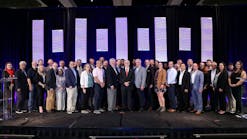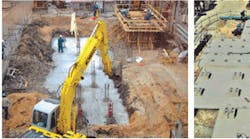Primarily shop-assembled and shipped by rail, truck, or barge to their final destination, today's industrial-class watertube steam boilers often are called “package” units. The term “package,” however, can be misleading, creating the impression these boilers can be purchased “off the shelf,” installed, and used to produce steam in a matter of weeks. In reality, package-boiler projects often are years in the making, requiring coordination and great attention to detail. This article discusses all that goes into a successful package-boiler project.
Project Phases
A typical package-boiler project can be organized into six distinct phases of work. Depending on the application and business requirements, at least 18 to 24 months should be allowed for the process.
Phase 1: project requirements and business case
Often at least two years before steam is needed from a boiler, operating requirements are established and important decisions about how the boiler will be integrated into an application are made. Most new-boiler projects are driven by one or more of the following:
-
The need to replace equipment nearing — or at — the end of its service life. Built and installed during the 1960s and ‘70s, thousands of today's industrial-class watertube package boilers are nearing or have reached the end of their practical service lives, as evidenced by chronic leaks and fouling and poor efficiency. While much can be done to “plug the dyke” through repair, cleaning, and replacement of components, sooner or later, these units will have to be replaced. Particularly in the petrochemical industry, millions of dollars can be lost for every day a boiler is not operating.
-
A desire to reduce operating costs. Today's boilers can be configured to deliver an average efficiency of 83 percent when a feedwater economizer is used and over 90 percent when a condensing exchanger and air pre-heaters are used. With today's fluctuating energy costs, just a 1-percent improvement in efficiency can mean significant savings.
-
The need to reduce emissions to meet new air-quality standards. Sometimes, an older boiler can be retrofitted with a selective-catalytic-reduction (SCR) solution or an ultralow-nitrogen-oxide (NOx) burner and flue-gas-recirculation (FGR) solution to meet emissions requirements. However, when reduced emissions is coupled with improved efficiency, such retrofits can have a less attractive payback than a new boiler.
-
The need to support business growth. Operating costs, return on investment, and emissions requirements are no less important when the reason to consider a new boiler is to meet the growth demands of one's business.
In any case, core questions about a boiler solution must be answered before budgeting can begin:
-
What is the required steam capacity? If operation across a wide range of capacities is needed, a single boiler will be limited on both the top and the low ends of capacity, with predictable performance often ranging from 25 to 100 percent of design capacity. If predictable performance across a wider range of capacities is required, modularization across several boilers, which provides flexibility to operate all boilers at 100-percent capacity or only one at less than 25-percent capacity, can be considered. Operating ranges vary based on the steam pressure a solution requires and whether the plan is to generate saturated steam or superheated steam, assuming both high pressure and high temperature are required.
-
What fuels will be burned? Boilers can be configured to operate on multiple gas and liquid fuels. Many petrochemical operations have the luxury of burning waste gas or byproducts from their refining processes. Depending on the chemical content of waste gas, boilers often can serve as both steam generators and incinerators.
-
What are the emissions limits? Often, the most important question regarding emissions limits concerns NOx. Some regions require 9 ppm of NOx, although many are moving to 5-ppm limits. The most stringent emissions standards often are met by coupling low- and ultralow-NOx burner technology with FGR and SCR solutions.
-
Where will the boiler be placed, and how will it connect to the rest of the operation? Space in a plant can be at a premium, particularly when an existing boiler is being replaced. Boilers can be configured in a number of horizontal and vertical arrangements to optimize available space.
Phase 2: budget
A budget should consider all equipment used to meet business needs and operating requirements. Often, a boiler represents less than 25 percent of the overall cost of a solution. The cost of auxiliary equipment, control systems, instrumentation and monitoring equipment, civil construction and site work, installation, and start-up should be considered. If an engineering firm is enlisted, those costs should be considered as well.
Page 2 of 3
Phase 3: detailed engineering
The detailed-engineering phase of a project starts the 12 months typically required to design, fabricate, install, and commission a boiler. One way to begin this phase is with a diagram communicating the key requirements for both the water side and the fuel/combustion side of a solution. These requirements will drive the physical design of the solution and determine the size of the core components. Making these decisions early in a project is important to getting long-lead equipment items sized and on order. From there, piping and instrumentation diagrams can establish how a boiler will be controlled and operated and how steam, feedwater, and fuel systems will be integrated into the overall plant. Generally, Phase 3 is complete when the physical arrangement and plot plans for equipment, structural steel, and piping are finalized.
As important as keeping a project on time and on budget is ensuring that it is engineered efficiently and that the operations staff is engaged. Even the most elegantly engineered solution will break down if it is out of synch with the operating strategies and capabilities of the plant staff.
Phase 4: equipment and materials procurement and fabrication
The procurement and fabrication phase runs concurrently with the detailed-engineering phase. To meet a 12-month project schedule, boilers, burner and controls packages, and forced-draft combustion-air fans must be ordered within weeks of the start of a project. Lead times for remaining components range from six to 20 weeks. To support an overall job schedule, equipment lead times must be matched to engineering time and drawing-review and approval time. The goal should be that virtually all equipment is delivered to the installation site during the first week of the installation phase (the first day of the eighth month of the 12-month design, fabrication, installation, and commissioning timeline).
Phase 5: Installation
The installation phase starts with site preparation and civil construction. Depending on the installation location, old equipment may need to be removed. At a minimum, robust foundations designed to support each piece of equipment must be built. This work should be completed two weeks before boilers arrive at a site and mechanical installation starts. Overall installation typically takes 16 weeks in a petrochemical-plant environment and a bit less time for a large commercial installation, such as a university campus or a hospital complex. Depending on their size, boilers will be delivered by truck, rail, or barge; almost always, they require specialized equipment and transport permits to be delivered and set on a foundation. From there, the economizer, SCR reactor house, stack, and interconnecting ductwork will be set. The burner might be installed in the field or at the boiler-fabrication shop. For larger boiler installations, fuel trains are skid-mounted, and forced-draft fans are set on their own foundations. If a boiler is a plant's first, water-treatment systems and feedwater controls will be set, and water, steam, and fuel piping will be run to connect the equipment on the boiler island and tie the solution into the plant. Mechanical installation will be complete once the system is hydrostatically tested. At that point, more-sensitive instruments can be mounted or installed, and insulation for thermal efficiency or personnel protection can be applied. The last part of this phase is completion of electrical wiring and instrument air tubing and the checking of loops for completeness and integrity.
Phase 6: start-up and commissioning
To ensure a smooth start-up, a qualified combustion engineer should be engaged before construction is complete. Start-up times can vary greatly, depending on the control schemes selected, the number of fuels to be burned, the emissions-control equipment included, and even the quality of the installation.
Page 3 of 3
In general, start-up begins with the first light of a boiler. The first light exercises all components on the fire side of a solution, including fuel systems and controls, and air-handling systems, including the forced-draft fan and dampers. A chemical boilout prepares the water side of drums and tubes by cleaning lubricants and mill scale from metal surfaces. After that, a boiler is flushed and cooled, and an inspection of all system components is performed. The system now is ready to be loaded and performance across the full range of operating conditions tested. That process sets controls curves, verifies integration with plantwide control systems, and confirms automated operations for positive and negative scenarios. The phase is completed with emissions-control-system checkout and tuning, which often includes a third-party emissions test to verify the solution is compliant with the operating permit.
Start-up and commissioning provides a great opportunity to train operations staff. Involve operators from the beginning, providing both classroom and hands-on training.
Life-Cycle Operations
A well-designed, appropriately installed boiler solution should serve a business for a generation, if not longer. Regular inspection, accompanied by annual combustion tuning and calibration of instrumentation, should keep a boiler running smoothly. However, the very nature of a boiler is that it operates in an extreme, often hostile, environment. Tube leaks can occur, surfaces can foul, and regular maintenance and repairs can be expected. To get full value and optimize the life of your investment, work closely with operators and a qualified boiler-maintenance-and-repair service to establish a proactive inspection and maintenance plan, and be prepared for unplanned incidents.
Jeff Guillot is president and chief operating officer of Halgo Power Inc. (www.halgopower.com), specialist in turnkey solutions for package and field-erected boilers ranging from 30,000 to 500,000 lb of saturated and superheated steam per hour for the refining, petrochemical, pulp-and-paper, and pharmaceutical industries, as well as university and medical-center campuses. A graduate of The University of Texas with a bachelor's degree in mechanical engineering and former Fortune 50 executive, he has 23 years of business experience.
Keys to Project Success
Following are tips for successful implementation of a boiler project:
-
Start planning early. Allow at least 18 to 24 months from budgetary planning to making steam.
-
Understand the business reasons for undertaking a project. Test every decision against those reasons.
-
Identify project milestones, and manage work to keep those milestones on schedule.
-
Understand interdependencies with other projects, and plan accordingly.
-
Order long-lead items, including the boiler, burner, control package, forced-draft fan, and SCR catalyst, within the first few weeks.
-
Finalize system piping and instrumentation within the first six to eight weeks. Involve the operations staff.
-
Choose an experienced boiler-solutions provider to partner with the engineering vendor.
-
Keep all stakeholders informed of progress, and ensure they know when their contributions are needed.









